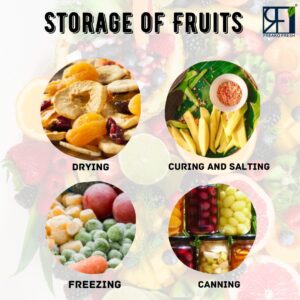
Fruits are a multi-flavoured, colourful way to good health. They are important sources of vitamins and carbohydrates like fibre and sugar. They are low in calories and naturally sweet. Fruits and their juices are good sources of water, too.
The various techniques for the storage of fruits are:
Drying:
One of the oldest ways to preserve produce is through drying. The basic procedure involves the removal of moisture from the product to a point where decay is not likely. Once finished, the product should be stored in a dry place in air-tight containers. Dried produce does not retain the quality and nutritional value found with fresh produce. The process is also fairly labour intensive and time-consuming. However, certain products, such as beans, peas and other legumes, can be dried without much loss.
Canning:
A resurgence of interest in canning is taking place as it has become easier with more fool-proof methods and good equipment like regular jars, lids and more reliable and safer pressure cookers. With the pressure cooker method, the product is heated to kill microorganisms that can cause spoilage. This action also deactivates enzymes in the products that affect flavour, texture and colour. Canning can incur added costs with the purchase of equipment, containers and general supplies. It also is labour intensive. For most types of produce, higher food quality can be maintained with canning rather than drying.
Curing and Salting:
If certain garden produce is allowed to ferment naturally, it is said to have become “cured.” This means that microorganisms initiate the fermentation process and change the food quality without causing bad tastes or generating toxins. The best example of natural curing is with cabbage that ferments into sauerkraut. During the fermentation process, large amounts of acids are produced which control the fermentation process by ultimately limiting the microbial action as the food becomes more acidic. A second way to cure food is by adding organic acid like vinegar to increase acidity and limit microbial activity. When salt is added in sufficient quality, this too will control microbial action and effectively stop the growth of spoilage organisms. Curing and salting is not a common method of preserving garden produce because of the great change that it makes in the quality and overall taste.
Freezing:
A common and very desirable way to preserve certain types of garden produce is through freezing. This method does not improve quality but is fairly easy to do if one has access to a freezer and takes the time to package properly so that moisture is retained. Like other preservation methods, freezing prevents microorganisms from growing causing spoilage. One large advantage of freezing is that the nutritional quality remains relatively good, plus food can be kept for many months with little change in color. For certain soft produce, the texture may change considerably, though the importance of this is largely depends upon how the food will be subsequently used. Green peppers can be frozen but will become watery when brought back to room temperature. The texture will be very different from fresh produce, but the color will remain good.
